The Snapdragon 855 Phone Roundup: Searching for the Best Implementations
by Andrei Frumusanu on September 5, 2019 8:30 AM ESTSystem Performance
Differences in system performance between devices with the same hardware chipset basically boil down to one aspect: software. When a vendor starts developing a new phone based on a new chipset, they are supplied by the chipset vendor with a base software package (BSP) containing the boilerplate drivers and Android implementation upon which the vendors can then go and customize and optimize to their liking. This development happens early in a device’s development life-cycle, and different vendors have different approaches as to how they go ahead and further optimize the BSP.
The biggest differences we see between the various devices today simply come down to the matter on when exactly the vendor has forked off their development branch from Qualcomm’s official BSP branch. Even earlier in the year I saw quite a lot differences between various Snapdragon 855 devices such as the Galaxy S10 and the G8, both having different versions of CPU schedulers at different stages of their implementations.
Such differences we also saw earlier in the year where Qualcomm’s Snapdragon 855 performance preview on the reference devices were running lower performing BSPs than what were found on the Galaxy S10. The question is now which vendors put in the effort to try to optimize the most out of the software stack, and which vendors were content to just leave things as they are.

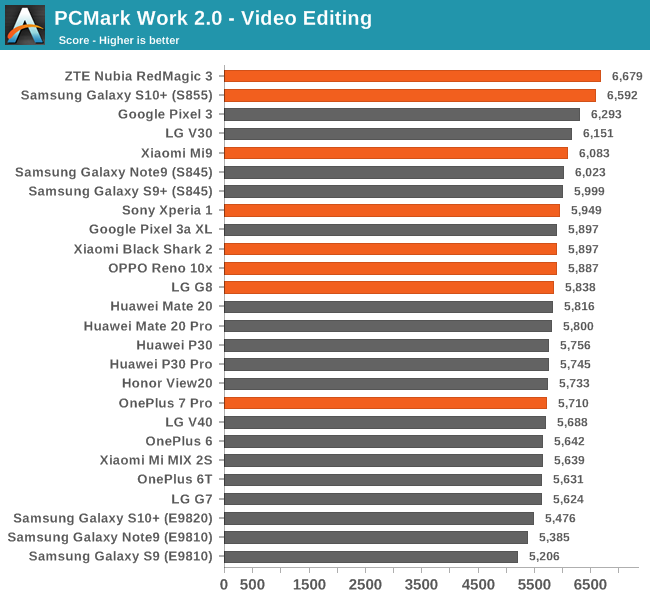
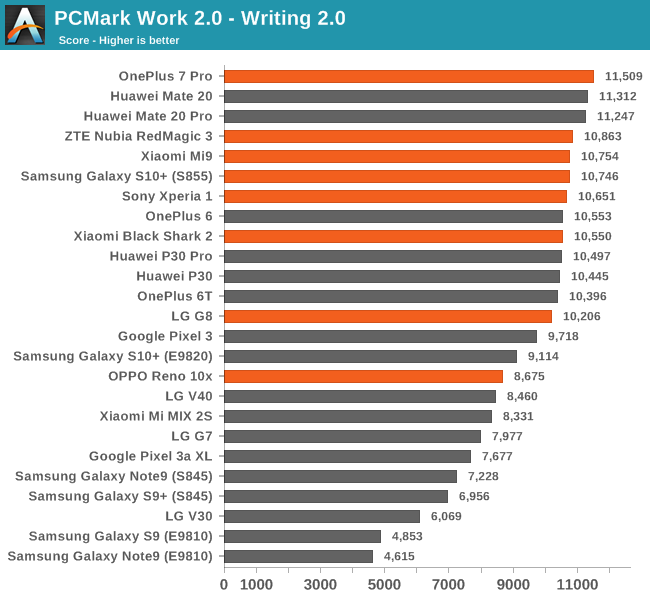
The writing sub-test is amongst the most important ones in PCMark as it’s the most representative of real-world performance experience of a phone. Here, all the Snapdragon 855 phones perform very well, except for the OPPO Reno.
I have to mention that the phone I’ve reviewed came with the Chinese firmware variant. The OS offered a “Performance” mode, however this mode was quite dishonest as it simply pegged the CPU frequencies to their maximum, instead of serving as a more responsive DVFS mode as found on the performance modes of phones such as from Samsung or Huawei.
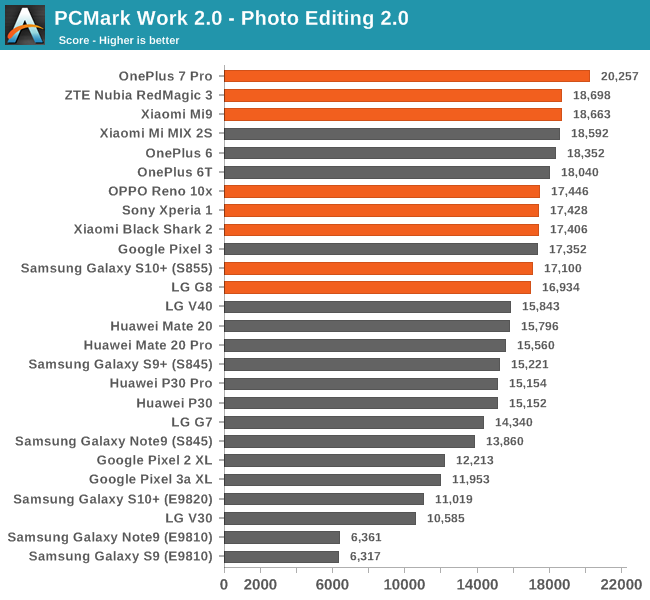
The OnePlus 7 Pro lead the pack here in the Photo Editing test which makes use of RenderScript Android API image processing functions, likely due to it’s 90Hz screen which does improve the measured responsiveness of the benchmark.

Interestingly, the RedMagic 3 leads the pack here when it comes to the data manipulation test which is characterised my a mixed thread workloads with a larger single heavy thread, pointing out to better scheduling on the part of the ZTE device and its software.
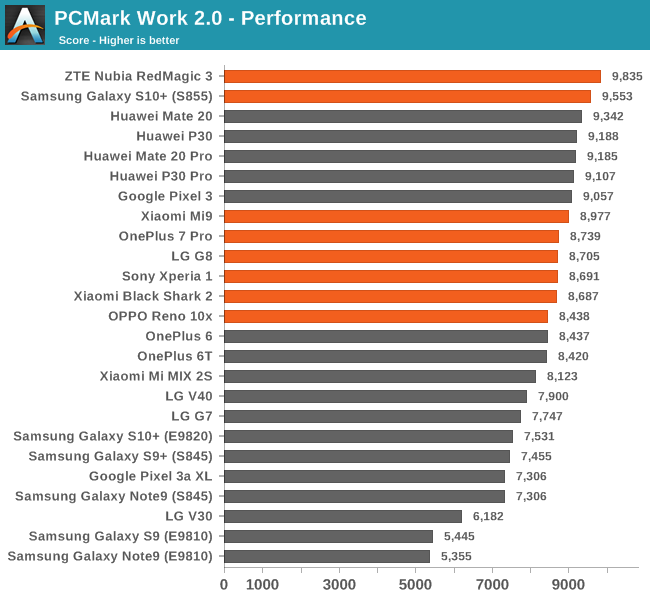
Finally, in the overall score, the ZTE RedMagic 3 comes at the top alongside the Galaxy S10. It seems that these two devices have the newest and most performance scheduler versions made available by Qualcomm, and why they end up at the top of the pack.

In the JavaScript web browser benchmarks, we again see a bit of a spread spectrum when it comes to the resulting scores. In Speedometer 2.0 the Galaxy S10 oddly remains as the worst performing device whereas other phones are more closely following the top performance of the Kirin 980.
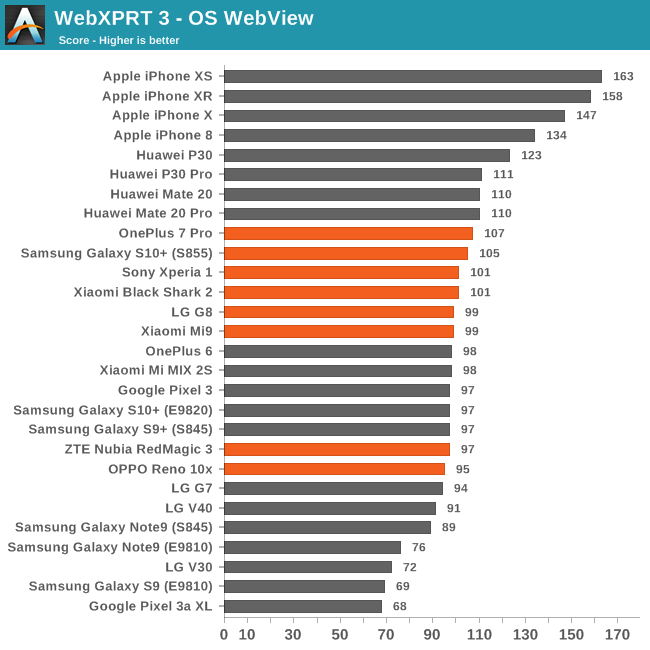
In WebXPRT 3, the S10 and OP7Pro take the top spots, although again slightly behind the Kirin 980 chipset devices from Huawei.
Overall, performance of all the Snapdragon 855 were quite excellent and all phones are among the fastest devices on the market, which should come as no surprise to anyone.










47 Comments
View All Comments
yeeeeman - Thursday, September 5, 2019 - link
Andrei, this is nice, but we could guesstimate how an 855+ will behave.We really want to see Exynos 9825 since that is harder to estimate.
Andrei Frumusanu - Thursday, September 5, 2019 - link
I don't have the 9825/Note10 yet, we'll have to buy one. Currently this won't happen till maybe October as it's going to be busy with other stuff the next few weeks.LarsBolender - Thursday, September 5, 2019 - link
But you are going to review the 9825, are you?rocketman122 - Thursday, September 5, 2019 - link
all I care about is if the camera is great, and the op7 is garbage as has been all the others before it.FunBunny2 - Thursday, September 5, 2019 - link
"all I care about is if the camera is great"and, how many phone companies make the cameras? it is, of course, just a matter of buying off-the-shelf from other vendors.
IUU - Friday, September 6, 2019 - link
Lol! Couldn't care any less about the camera! But each to his own.cha0z_ - Monday, September 9, 2019 - link
It would make an interesting read to see the benefits going from 8nm to 7nm, but from what is known - the benefits are super slim to even justify doing that in the first place for something different than "beta test" the 7nm for the next year SOC.There are more interesting things that comes like the A13 SOC and the next kirin.
FunBunny2 - Thursday, September 5, 2019 - link
"all I care about is if the camera is great"and, how many phone companies make the cameras? it is, of course, just a matter of buying off-the-shelf from other vendors.
philehidiot - Saturday, September 7, 2019 - link
I look at these charts and I get angrier and angrier about Samsung forcing me into Exynos when the performance (and other subsystems) are really quite inferior. It's marketed as one product but it's two very different phones. I compare this to motorbikes as that's my thing. A 1000cc Fireblade is NOT the same bike as a 650CC version. They are similar in looks and similar in purpose but they handle and perform differently and are worth different amounts because of this. I, personally, would be absolutely fine with a 650cc version as it would suit my riding better. I would NOT be fine with someone selling me a "Fireblade" and not specifying in the advert what model it is and trying to sell me a 650cc as if it was the same value as a 1000cc. Both models are marketed as different bikes with one called the CBR1000RR and the other the CBR650R. Just because they look similar and share many similar components does not mean they are the same machine when the core elements are different. Both have excessive performance for the road - more than you'll ever be able to apply and so arguing that the phones are both satisfactory for the market is missing the point.Samsung need to recognise they can not go selling an inferior phone under the same name as another model and using the same marketing as if they both have the same value. And if you're ever wondering, just ask yourself this - if you could have either a Snapdragon or an Exynos model and they'd both work the same on the networks you use, etc.... would you really choose the slower one for the same money? No, you'd go for the faster one with the better DSP, better imaging, better sound quality, etc.
My other concern is that, whilst these are both adequate now, I might want my phone to last longer than the usual 2-3 years. What if I want 5? Mine is an S8 and it's already showing signs of slowing down as software requirements increase. So if you start off with a faster phone, logically it will likely make a difference towards the latter end of its life. So I buy an inferior phone which also has a shorter useful life and I'm expected to value it the same as the other model?
Samsung, please tell your marketing department to kindly piss off. The bunch of raging arse parsnips.
s.yu - Sunday, September 8, 2019 - link
I don't get your point, they're not for the same money, not even in the same range as twice I bought an SK variant Samsung for ~30% less than Mainland China's.They also have different code names. Note 10+ for example, directly from GSMA: Versions: SM-N975F (Europe); SM-N975F/DS (Global); SM-N975U (USA); SM-N975U1 (USA unlocked); SM-N975W (Canada); SM-N9750/DS (LATAM, Brazil, China); SM-N975N (South Korea)